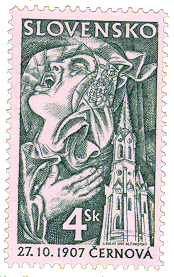Catalogue Number:
Stamp Design:
Stamp Engraving:
Date of Issue:
Printing:
Print Technology:
Print Run:
|
135
Jozef Baláž
Martin Činovský
October 24, 1997
Postal Stationery Printing House, Prague
Rotary-recess printing combined with recess printing
2,100,000
|
The earliest preserved reference to Černová near Ružomberok (in the form Csernow) dates from 1461.
Andrej Hlinka, the Catholic priest and campaigner for the rights of the Slovaks, was born here in 1846. Parish priest in Ružomberok from 1905, Hlinka was the principal force behind moves to build a church in Černová, an aspiration realised thanks to the invention and donations of its citizens. The planned consecration of the building on 27th October, 1907 failed to take into account the will of the townsfolk, who were adamant that the ceremony should be carried out by their fellow citizen, Hlinka.
The bloody confrontation that resulted claimed fifteen lives, with eighteen people incarcerated and a further fifty-nine arraigned.
Černová brought the existence of the Slovaks as a distinct entity to international notice, and the nation views the events as a tragic chapter in its history. The Černová Bloodbath, as it has come to be known, occurred at a time of deep political and social crisis and national conflicts within the multinational Hungarian Kingdom.
The sufferings of the Slovaks in pursuing their rights were brought to international attention - despite the diispleasure of the Hungarian establishment - by the Norwegian writer Björnstjerne Björnson and the British historian Seton-Watson.
|

